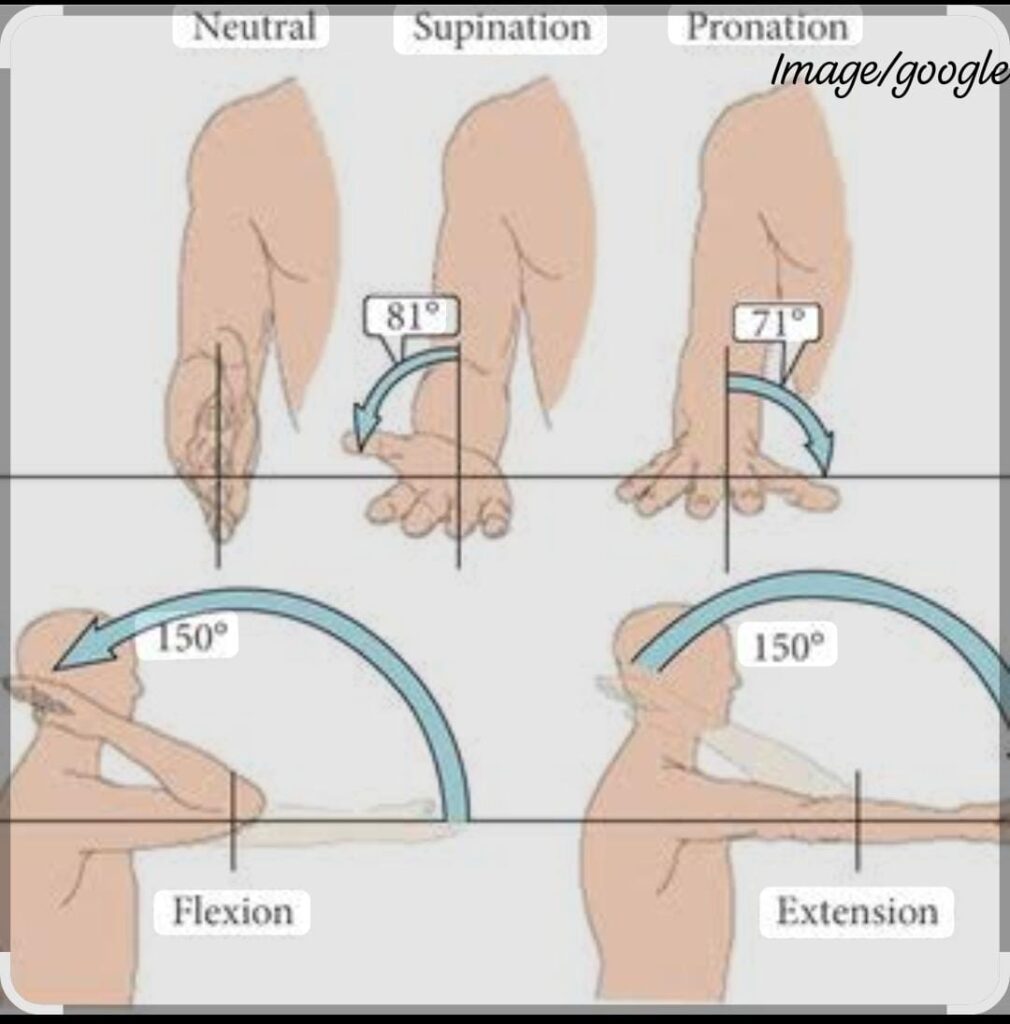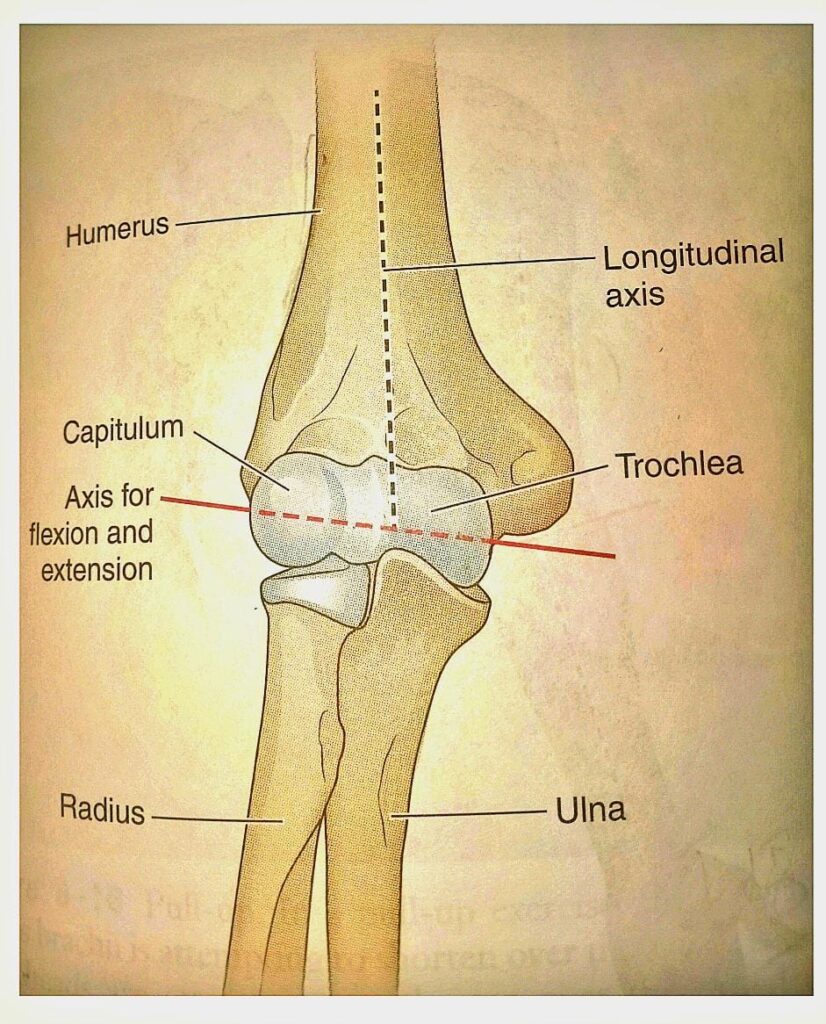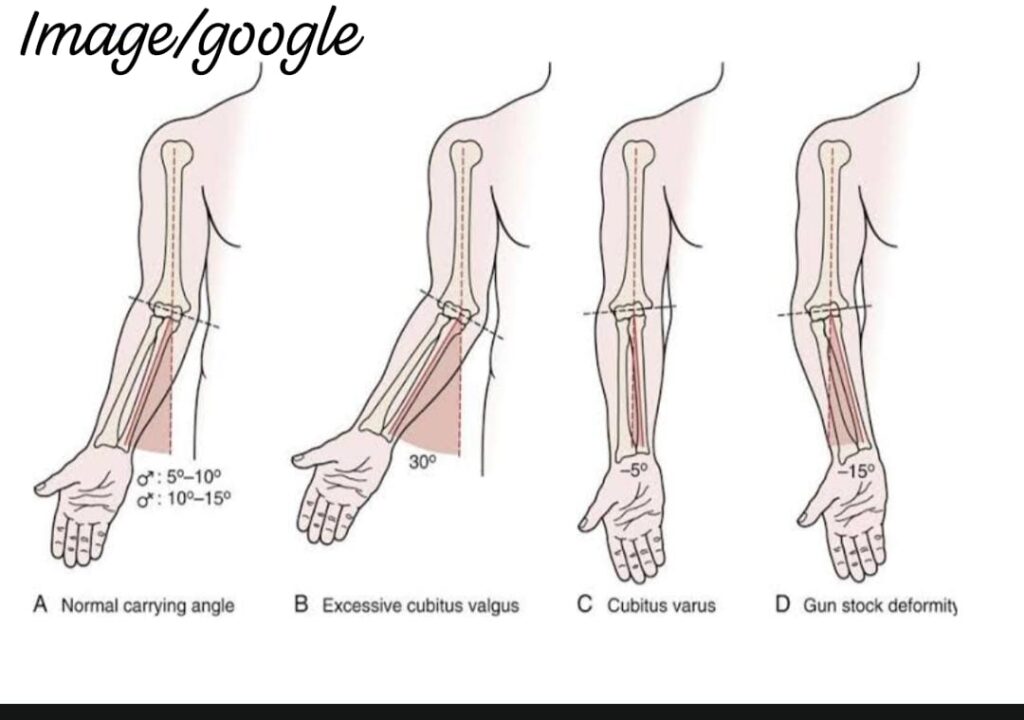The Elbow Joint is a hinge variety of synovial joint. The word Elbow is derived from the Latin word Cubitus. It forms by the articulation of Distal part of the humerus and proximal part of Ulna and Radius. This joint helps to perform various movement such as Flexion and Extension, Supination and pronation. This joint allows the stability as well mobility while motion.

Table of Contents
Axis Of Motion

- The axis for flexion and extension has been briefly detailed as a relatively fixed line that passes horizontally through the center of the trochlea and capitulum which bisects the longitudinal axis of the shaft of the humerus.
- An exact determination of the axis of motion at the elbow is important because of the need to position the elbow prostheses in such a way that they correctly mimic elbow joint motion.
- Variations found in the inclination of the instantaneous axis support the hypothesis that activity of the various muscles may influence the pattern of motion during active flexion and that differences contours of the joint surfaces may explain inter-individual differences.
Long Axes of The Humerus and forearm

- When the upper extremity is in the anatomical position the long axes of the humerus and forearm form an acute angle laterally at the elbow.
- The angulation occurs because the medial aspect of the trochlea extends more distally than does the lateral aspect, with the capitulum slightly above the trochlea
- This angulation is called the carrying angle and is typically around 15° but may vary from about 8° to 15°, When this carrying angle is atypical and exceeds 15% the condition is referred to as cubitus valgus, whereas a reduced (≤ 5) or reversed carrying angle is referred to as cubitus varus.
- If the angulation is a result of postinjury complication (supracondylar fracture), it can be referred to as Gunstock Deformity.
The mean carrying angles have been found to be significantly larger in female children than in male children in the same age group from age 1 year on.” Although there is a normal angulation between the humerus and the forearm in elbow extension, the obliquity of the elbow axis results in a change in the relationship of the forearm and humerus with elbow flexion. - With a typical inclination of the elbow joint axis, the ulna is guided progressively medially from extension to flexion so that in full flexion, the forearm comes to rest in the same plane as the humerus
- With an increase in the elbow joint axis (cubitus valgus), the forearm will come to rest medial to the humerus in full flexion or may come to rest lateral to the humerus with more extreme degrees of cubitus varus.
Mobility and Stability of the Elbow Joint
- A number of factors determine the amount of motion that is available at the elbow joint. These factors include the type of motion (active or passive), the position of the forearm (pronation/supination), body mass index (BMI), and the position of the shoulder.
- The range of active flexion at the elbow is usually less than the range of passive motion because the bulk of the contracting flexors on the anterior surface of the humerus may interfere with the approximation of the forearm with the humerus.
- The active ROM for elbow flexion with the forearm supinated is typically considered to be from about 135° to 145°, whereas the range for passive Alexion is between 150° and 160°
- The position of the forearm also affects the flexion ROM. When the forearm is either in pronation or in neutral supination/pronation, the ROM is less than it is when the forearm is supinated.
- A BMI that is high (indicating overweight) may also be a factor limiting elbow ROM. The position of the shoulder may affect the ROM available to the elbow joint because of the influence of the two- or multi-joint biceps brachii and the triceps brachii. If a full ROM is attempted at the shoulder and the elbow simultaneously, these muscles may become actively or passively insufficient.
Extension Of The Elbow Joint
- The humeroulnar joint is in a close-packed position. Bony contact of the olecranon process in the olecranon fossa limits the end of the extension range, and the configuration of the joint structures helps provide valgus and varus stability.
- The bony components provide 50% of the resistance to varus stress in full extension, and the lateral collateral complex and joint capsule provide the other 50% of the resistance.
- Resistance to joint distraction in the extended position is provided entirely by soft tissue structures. The anterior portion of the joint capsule provides the majority of the resistance to anterior displacement of the distal humerus out of the trochlear notch, the medial and lateral collateral ligaments contribute only slightly.
- In 90° of flexion, the anterior part of the medial collateral ligament provides the primary resistance to both distraction and valgus stress. If the anterior portion of the medial collateral ligament becomes lax through overstretching, medial instability will result when the elbow is in flexed positions.
- The majority of the resistance to varus stress when the elbow is flexed to 90° is provided by the osseous structures of the joint; only a slight amount is provided by the lateral collateral ligament and the joint capsule.
- Active and passive tension in the muscles that cross the elbow, as is true of most muscles, contributes to stabilization of the joint through compression.
- Co-contractions of the flexor and extensor muscles at the elbow provide a stable base for forceful motions of the wrist and fingers because several of the muscles that cross the wrist and fingers also cross the elbow joint.
Muscle Action of the Elbow Joint
Muscles of Flexors
- The brachialis is considered a mobility muscle because its insertion is close to the elbow joint axis, an attachment that favors production of the large arc of motion at the distal segment.
- The moment arm of the brachialis is greatest at slightly more than 100degree of elbow flexion.
- The brachialis muscle works in flexion of the elbow with and without resistance and during slow and fast motion.
- The biceps brachii, like the brachialis, is considered to be a mobility muscle because of its insertion close to the elbow joint axis that favors a large arch of distal movement.
- The long head of the biceps brachii has the largest volume among the flexors, but the muscle has a relatively small physiological cross-sectional area.
- The moment arm of the biceps is greatest between 80degree and 100degree of elbow flexion, giving the biceps a strong torque generation potential in this range.
- The moment arm of the biceps is small as the elbow approaches full extension, with most of the muscle force applied parallel to the forearm (translation) and toward the joint (compression).
- Therefore, the biceps is less effective as an elbow flexor when the elbow is fully extended than when the elbow is flexed to 100″
- When the elbow is flexed beyond 100′, the translatory component of the muscle force is directed away from the elbow joint and therefore acts as distracting or dislocating force.
- The biceps brachii is active during unresisted elbow flexion if the forearm is supinated or in neutral pronation/supination, but tends not to be active in unresisted elbow flexion when the forearm is pronated.
- The brachioradialis is inserted at a distance from the joint axis, with the largest component of muscle force going toward compression of the joint surfaces and, hence, toward stability.
- The brachioradialis has a relatively small mean physiological cross-sectional area (1.2 cm), but a relatively large average peak moment arm in comparison with other elbow flexors, with the peak moment arm for the brachioradialis occurring between 100 and 120° of elbow flexion.
- The brachioradialis does not cross the shoulder therefore, it is unaffected by the position of the shoulder.
- The brachioradialis shows no electrical activity during eccentric flexor activity when the motion is performed slowly with the forearm supinated, or during slow, unresisted, concentric elbow flexion.
- When the speed of the motion is increased, the brachioradialis shows moderate activity if a load is applied and the forearm is either in a neutral forearm position or in full pronation.
- The pronator teres and other muscles that cross the elbow joint (palmaris longus, flexor digitorum superficialis, flexor carpi radialis, and flexor carpi ulnaris) are weak elbow flexors with primary actions at the radioulnar and wrist joints.
Extensors of the Elbow Joint
- The effectiveness of the triceps brachii as a whole is unaffected by changes in position of the forearm because the triceps attaches to the ulna and not the radius.
- The long head’s ability to produce force will diminish when full elbow extension is attempted with simultaneous shoulder hyperextension because the muscle is shortened over both joints at the same time, so it is approaching active insufficiency.
- The medial and lateral heads of the triceps are one-joint muscles so they are not affected by the position of the shoulder.
- The medial head is active in unresisted active elbow extension, but all other three heads are active when heavy resistance is given to extension or when quick extension of the elbow is attempted, even in a gravity-assisted position.
- Although maximum isometric torque has been observed at 90° of elbow flexion, the total amount of extensor torque generated at 90° varies with the position of the shoulder and the body.
- The triceps are active eccentrically to control flexion of the elbow Joint produced by the body weight as the body is lowered to the ground in a push-up.
- Throughout the push-up exercise, the relative ability of the long head of the triceps to generate force is maintained.
- When the elbow is extended (triceps shortened at the elbow, the shoulder is flexed (long head of the triceps is lengthened over the shoulder), when the elbow is flexed (triceps lengthened), the shoulder is extended (long head of the triceps shortened over the shoulder) in this way, active insufficiency of the longhead is avoided.
- The anconeus muscle contributes about 15%, whereas the biarticular long head of the triceps contributes significantly less.
- The triceps may be active during activities requiring stabilization of the elbow. For example, it acts as a synergist to prevent flexion of the elbow when the biceps is acting as a supinator.
- The other extensor of the elbow, the anconeus, assists in elbow extension and arguably acts as a stabilizer during activity.
To learn and understand more about Laser Therapy click the given link https://physiocontent.com/laser-therapy-lllt-physiological-effects/
To learn and understand more about Ultraviolet Radiation Therapy click the given link https://physiocontent.com/ultraviolet-radiation-therapy-and-its-physiological-effects/